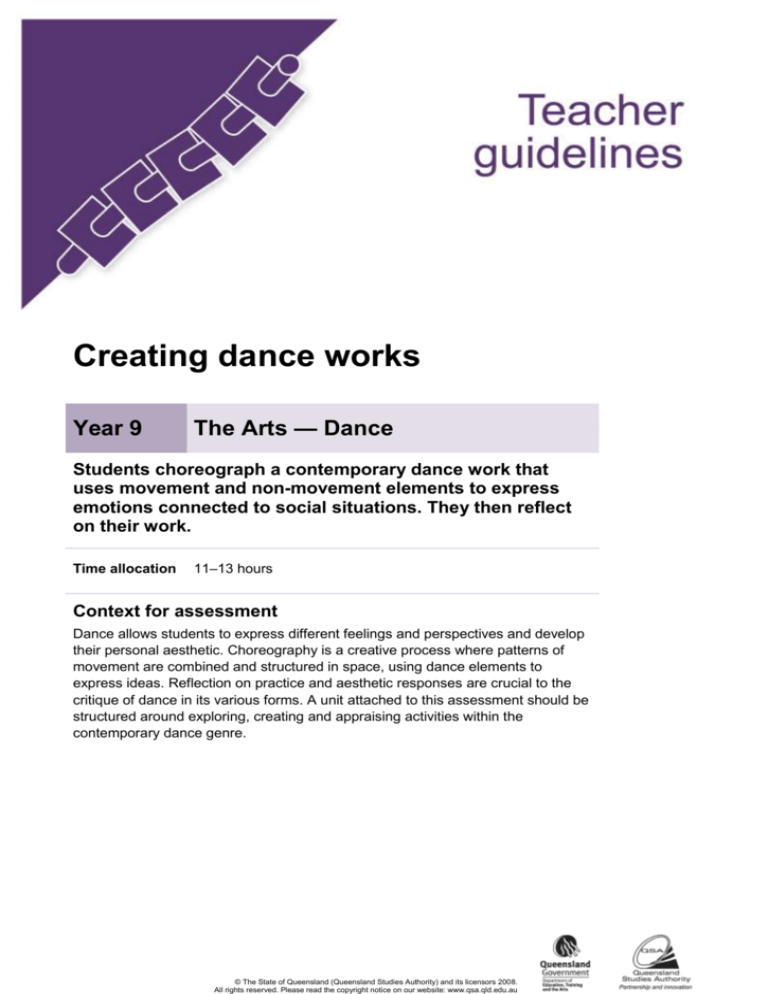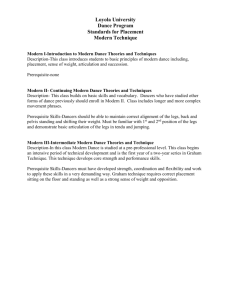
Creating dance works
Year 9
The Arts — Dance
Students choreograph a contemporary dance work that
uses movement and non-movement elements to express
emotions connected to social situations. They then reflect
on their work.
Time allocation
11–13 hours
Context for assessment
Dance allows students to express different feelings and perspectives and develop
their personal aesthetic. Choreography is a creative process where patterns of
movement are combined and structured in space, using dance elements to
express ideas. Reflection on practice and aesthetic responses are crucial to the
critique of dance in its various forms. A unit attached to this assessment should be
structured around exploring, creating and appraising activities within the
contemporary dance genre.
© The State of Queensland (Queensland Studies Authority) and its licensors 2008.
All rights reserved. Please read the copyright notice on our website: www.qsa.qld.edu.au
Teacher guidelines
This assessment gathers evidence of learning for the following Essential Learnings:
The Arts
Essential Learnings by the end of Year 9
Ways of working
Knowledge and understanding
Students are able to:
Dance
make decisions about arts
elements, languages and cultural
protocols in relation to specific
style, function, audience and
purpose of arts works
Dance involves using the human body to express
ideas, considering specific audiences and specific
purposes, by manipulating dance elements in
genre-specific dance sequences.
create and shape arts works by
manipulating arts elements to
express meaning in different
contexts
respond by deconstructing arts
works in relation to social, cultural,
historical, spiritual, political,
technological and economic
contexts, using arts elements and
languages
reflect on learning, apply new
understandings and justify future
applications.
Genre-specific movements are used to create
actions for dance sequences.
Traditional and non-traditional performance areas
are used to manipulate movement in space.
Irregular and mixed metres are used to manipulate
timing.
Combinations of movement qualities are used to
manipulate energy.
Structuring devices, including embellishment,
abstraction and variation forms, are used to
organise movement.
Assessable elements
Knowledge and understanding
Creating
Responding
Reflecting
Source: Queensland Studies Authority 2007, The Arts Essential Learnings by the end of Year 9, QSA, Brisbane.
2
Year 9 The Arts — Dance: Creating dance works
Listed here are suggested learning experiences for students before they attempt this
assessment.
Explore dance elements (e.g. action, space, time, energy and form) and their use in
contemporary dance.
Explore specific choreographic devices (e.g. abstraction, embellishment, variation,
accumulation and retrograde) that help shape dance to express ideas.
Explore non-movement elements (e.g. music and technology) to help support choreographic
ideas.
Investigate methods of responding to a given theme through choreography.
Develop, model and practise methods to analyse and evaluate the choreographic process,
including:
—
creating a concept map
—
writing a process journal.
View and discuss a variety of dance works and then write extended responses.
Participate in contemporary dance classes to develop and support movement vocabulary.
Participate in peer and self-reflection activities that focus on the choreographic process.
Teacher resources
Appendix A
Dance terms
Blom, L & Chaplin, L 1982, The intimate act of choreography, University of Pittsburgh Press,
Pennsylvania, USA.
“Aspects of dance and design”, Co’Motion, Valerie Williams Dance Theatre, accessed 14 March
2008, <www.comotion.org/docs/res/aspects.htm>.
“Teacher’s notes: Glossary”, The Arts exemplars: Dance, Te Kete Ipurangi — The Online Learning
Centre, accessed 14 March 2008,
<www.tki.org.nz/r/assessment/exemplars/arts/dance/teachers_notes/tn_glossary_e.php>.
3
Teacher guidelines
Preparing
Consider these points before implementing the assessment.
You will need to prepare a safe working environment — a large uncluttered area where
students can move safely without bumping into each other, the walls or furnishings. Read
through “Organising a dance classroom” in the resource, Appendix B: Dance classroom
management, for guidelines.
A warm-up and cool-down is an essential part of any movement lesson. The resource,
Appendix B: Dance classroom management, has suggested activities you may wish to use.
Implementation
Consider these points when implementing the assessment.
Allocate 8–10 hours to complete Section 1, and 3 hours to complete Section 2.
Guide students through the steps providing opportunities for self, peer and teacher feedback.
Video-record the presentation of the dance works to provide a reference for the written
response.
Students may approach the assessment in a number of ways. They may choose to:
work individually or in small groups. Each member of a group must be responsible for a distinct
section of the work — for example, one minute of choreography in which each person can
demonstrate their use of movement elements (structuring devices such as abstraction,
embellishment, variation, accumulation and retrograde) and non-movement elements (music
and technology) to express ideas
choreograph their work for their classmates and not perform the piece themselves
develop a piece of virtual choreography using a suitable software program such as
DanceForms (© 2006 Credo Interactive Inc.).
4
Year 9 The Arts — Dance: Creating dance works
Resources for the assessment
Appendix B
Dance classroom management
Appendix C
Guidelines for critique
Music and music players
Digital images or overhead transparencies (OHTs)
Data projector or overhead projector (OHP)
Digital video camera and video of dance works
5
Teacher guidelines
During the learning process, you and your students should have developed a shared
understanding of the curriculum expectations identified as part of the planning process.
After students have completed the assessment, identify, gather and interpret the information
provided in student responses. Use only the evidence in student responses to make your judgment
about the quality of the student learning. Refer to the following documents to assist you in making
standards-referenced judgments:
Guide to making judgments
Indicative A response
Sample responses (where available).
Making judgments about this assessment
When assessing the choreography, remember to base your overall judgment on the quality of the
manipulation of movement using the dance elements, rather than the number of elements used.
For further information, refer to Using a Guide to making judgments, available in the
Resources section of the Assessment Bank website.
Evaluate the information gathered from the assessment to guide teaching and learning strategies.
Involve students in the feedback process. Give students opportunities to ask follow-up questions
and share their learning observations or experiences.
Focus feedback on the student’s personal progress. Emphasise continuous progress relative to
their previous achievement and to the learning expectations — avoid comparing a student with
their classmates.
For further information, refer to Using feedback, available in the Resources section of
the Assessment Bank website.
6
Appendix A
Dance terms
Movement elements: action, spatial, time and energy (dynamics) and form (e.g.
choreographic devices).
Non-movement elements: dancers (number, gender, role, anatomical structures), setting
(performance spaces, costume, props, lighting, sets, multimedia) and aural elements (e.g.
music, spoken word, SFX, found sound and silence).
Choreographic devices: specific ways of creating new, or developing existing,
movement material.
—
Abstraction: the process of altering the appearance or features of the movement
phrase while maintaining the essence of the idea.
—
Embellishment: the process of ornamentation or decoration of movement (such as
adding a hand or head move).
—
Variation: an initial phrase or idea repeated with changes that alter the character,
style or mood of the initial idea.
—
Accumulation: new movements are added to existing movements in a successive
manner, (e.g. A, AB, ABC, ABCD).
—
Retrograde: a movement or sequence performed backwards (like rewinding a film).
Adapted from “Teacher’s notes: Glossary”, The Arts exemplars: Dance, Te Kete Ipurangi — The Online Learning Centre,
<www.tki.org.nz/r/assessment/exemplars/arts/dance/teachers_notes/tn_glossary_e.php>.
Appendix B
Dance classroom management
Organising a dance classroom
For a dance lesson to be a positive experience for all, consideration needs to be given to the space
where the lesson is to take place, as well as the way the lesson is conducted.
Clear the space of any desks, chairs and other moveable objects, so that all students are able to
move freely, on their own or in small groups in the space, without bumping into others or objects.
Ideally, a bare wooden floor, not lying directly in contact with concrete, is the most suitable flooring
for dance. If a carpet-covered, concrete floor is all that is available, it is advisable that no jumping
action takes place.
When using media equipment, it is important that it is on a table or shelf out of the way of the
movement that is taking place. Be aware of the volume of the accompanying recorded or live
music. If the music is too loud students will not be able to hear teacher instructions, there will be
risk of voice strain, and nearby classes will be interrupted.
The duration of a dance lesson should run approximately 35 to 45 minutes. This time does not
include set-up and pack-up time. The actual number of activities in a lesson will depend on how
much development or expansion of the activities takes place.
It is beneficial to revisit movement sequences or activities from previous lessons, so that students
build their movement vocabulary.
If students are required to remove their shoes, establish a place for the shoes that is out of the way
of the movement.
Encourage the students to wear clothing that is not restrictive, is modest, and offers protection from
the sun if dance is to take place outdoors.
Preparation for movement — warm-up and cool-down
Prior to beginning any movement lesson, a warm-up is essential. An ideal warm-up should involve
visual and verbal instructions from the teacher. During warm-up exercises it is important that each
student is able to follow teacher instructions.
Warm-up could include:
simple stretching and bending movements that involve the entire body
small gentle movements that isolate and prepare joints such as ankles and wrists
locomotor and non-locomotor aerobic exercises that raise heart rate and increase blood circulation.
The warm-up should be connected to the content or stimulus of the lesson to develop the
understanding that warm-up is preparation for movement and not an isolated experience. Using music
that reflects the stimulus of the lesson, or incorporating simplified versions of movements the students
may use in the lesson, is an easy way to do this.
During the cool-down, students should stretch slowly using movements that reflect the content of the
lesson in addition to familiar movements from the warm-up. Encourage students to reflect on what has
occurred during the lesson.
Safety considerations
Students should:
respect other students; allow them enough room to move without bumping into each other
remove shoes so that other students are not injured while moving on the floor
remove socks if the floor surface is slippery
not make physical contact with other students unless specifically requested by the teacher when
performing partner or group activities
be aware of the objects around the room that may need to be avoided — for example, the edges of
desks, chairs, windows or doorways.
Adapted from “Dance classroom management”, The Office of the Queensland School Curriculum Council 2002.
Appendix C
Guidelines for critique
Giving feedback
Feedback is an important part of the improvement process because it can provide
statements and questions that enable the students to see their own work from a different
perspective. Feedback can come from the teacher or fellow students, and through the use
of a video camera.
There are some ground rules that everyone needs to follow.
Make comments that are fair and respectful.
Use words thoughtfully.
Comment on the positive aspects first and then move on to areas in need of
improvement.
Try to use dance vocabulary whenever possible.
Self-assessment and peer-assessment guidelines for choreography
You might be able to comment on:
how well the choreographic devices been used to express the chosen emotions
how well the music supports the expression of the chosen emotions
how clearly the whole work expresses ideas about the chosen emotions.
Remember to include both strengths and suggestions for improvement.









